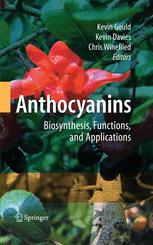

Most ebook files are in PDF format, so you can easily read them using various software such as Foxit Reader or directly on the Google Chrome browser.
Some ebook files are released by publishers in other formats such as .awz, .mobi, .epub, .fb2, etc. You may need to install specific software to read these formats on mobile/PC, such as Calibre.
Please read the tutorial at this link: https://ebookbell.com/faq
We offer FREE conversion to the popular formats you request; however, this may take some time. Therefore, right after payment, please email us, and we will try to provide the service as quickly as possible.
For some exceptional file formats or broken links (if any), please refrain from opening any disputes. Instead, email us first, and we will try to assist within a maximum of 6 hours.
EbookBell Team

0.0
0 reviewsIn recent years, knowledge of anthocyanin pigments has undergone unprecedented expansion. Indeed, the molecular genetic control of anthocyanin biosynthesis is now one of the best understood of all secondary metabolic pathways. Advances in analytical technology have led to the discovery of many novel anthocyanin compounds, dramatically enriching the palette used by plant breeders to introduce vibrant new colors into horticultural crops. The food industry, too, has benefited from this research; methods for stabilizing the colors of anthocyanins extracted from cell cultures have been optimized, opening the way for their use as natural food colorings.
Recent scientific research has also focused on the possible benefits to human health from the ingestion of anthocyanin-rich foods. Anthocyanins are remarkably potent antioxidants. These pigments, especially in conjunction with other flavonoids, have been associated with reductions in the incidence and severity of many other non-infectious diseases, including diabetes, cardiovascular disease and certain cancers.
Finally, there has been significant progress in our understanding of the benefits of anthocyanins to plants themselves. Originally considered an extravagance without a purpose, anthocyanins are now implicated in multifarious vital functions. These include the attraction of pollinators and frugivores, defense from herbivores, and protection from environmental stressors. Anthocyanins are highly versatile and enormously useful to plants.
This book covers the biosynthesis and function of anthocyanins (and the related proanthocyanidins) in plants, and their applications in agriculture, food products, and human health. The book addresses wide-ranging issues that include human nutrition, the pastoral sector, cell culture production systems, food colorants, flower and fruit color, plant biotic interactions, and the responses of plants to environmental stress.
Kevin Gouldis an Associate Professor in Biological Sciences at Victoria University of Wellington, New Zealand, where he teaches plant development and physiological plant ecology. He has a long-standing research interest in the functional significance of anthocyanins in leaves, stems and roots.
Chris Winefieldis a Senior Lecturer in Plant Biotechnology and Biochemistry at Lincoln University, New Zealand, where he teaches plant biochemistry and biotechnology applications in modern plant biology. He has a long-standing research interest in the metabolism and molecular biology of plant secondary metabolites, especially the production of anthocyanins in ornamental flower crops. Latterly he has begun work characterizing metabolic pathways responsible for the formation of flavor and aroma compounds in wine grape.
Kevin Daviesleads the Plant Pigments Team of Crop & Food Research, Palmerston North, New Zealand. His group studies the molecular genetics of pigment biosynthesis in ornamentals, fruit and vegetables. A particular interest is the transcriptional regulation of flavonoid biosynthesis.